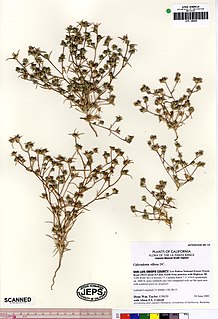
Calycadenia is a genus of flowering plants in the family Asteraceae, known commonly as the western rosinweeds. They are native to California, especially around the Central Valley. The ranges of two species (C. fremontii + C. truncata) do extend north into Oregon.

Erigeron blochmaniae is a species of flowering plant in the family Asteraceae known by the common names Blochman's erigeron and Blochman's leafy daisy.
Erigeron lassenianus is a species of flowering plant in the family Asteraceae known by the common name Mount Lassen fleabane.

Geraea viscida is a species of flowering plant in the daisy family known by the common name sticky geraea, or sticky desertsunflower. It is native to southern California, mainly the chaparral hills of eastern San Diego County, and nearby Baja California.
Holozonia is a North American genus of flowering plants in the family Asteraceae. It contains only one known species Holozonia filipes, which is known by the common name whitecrown. It is endemic to California.

Chaenactis artemisiifolia, with the common name white pincushion, is a species of flowering plant in the daisy family. It is native to the coastal Peninsular Ranges of Southern California and Baja California, in the chaparral and woodlands.

Blepharizonia plumosa is a California species of tarweed known by the common name big tarweed. It is endemic to central California, where it grows in the Central Coast Ranges and adjacent sections of the southern San Francisco Bay Area and Central Valley, from southern Sonoma County south as far as San Luis Obispo County.
Calycadenia fremontii is a species of flowering plant in the daisy family known by the common name Frémont's western rosinweed. It is native to southwestern Oregon and northern California. It is a common member of the flora in several types of habitat in the mountains, foothills, and valleys. This annual plant is variable in appearance.
Calycadenia hooveri is a California species of flowering plant in the family Asteraceae known by the common name Hoover's western rosinweed. It is endemic to a short portion of the western Sierra Nevada foothills, where it grows in rocky areas in the hills along from Amador County to Madera County.
Calycadenia mollis is a species of flowering plant in the family Asteraceae known by the common name soft western rosinweed. It is native to a section of central California, from Tuolumne County do northern Tulare County. There are also isolated populations farther north in Nevada County. The plant grows in a number of habitat types in the Central Valley and adjacent Sierra Nevada foothills.

Calycadenia multiglandulosa is a species of flowering plant in the family Asteraceae, known by the common names sticky calycadenia and sticky western rosinweed. It is endemic to California, where it is a common in the Coast Ranges and in the Sierra Nevada Foothills from Shasta County to Kern County.
Calycadenia pauciflora is a species of flowering plant in the family Asteraceae known by the common name smallflower western rosinweed. It is endemic to northern California, where it grows in the Coast Ranges north of the San Francisco Bay Area from Napa County to Tehama County.
Calycadenia spicata is a species of flowering plant in the family Asteraceae known by the common name spiked western rosinweed. It is endemic to central California, where is a common grassland plant in the Central Valley and adjacent Sierra Nevada foothills from Butte County to Kern County.
Calycadenia truncata is a species of flowering plant in the family Asteraceae known by the common name Oregon western rosinweed. It is native to southwestern Oregon and northern and central California. It is found in the Cascades, the Coast Ranges, and the foothills of the Sierra Nevada as far south as Monterey and Tulare Counties.

Calycadenia villosa is an uncommon species of flowering plant in the family Asteraceae known by the common name dwarf western rosinweed. It is endemic to central California, where it is known from a limited distribution in the Central Coast Ranges in Monterey County and San Luis Obispo County, with a few populations in Santa Barbara and western Fresno Counties. There are perhaps 16 occurrences.
Crepis bakeri is a species of flowering plant in the daisy family known by the common name Baker's hawksbeard. It is native to the western United States where it grows in many types of mountain and plateau habitat. It is found in Oregon, Washington, Idaho, northern California, Nevada, and Utah.

Erigeron petrophilus is a species of flowering plant in the family Asteraceae known by the common names rockloving erigeron or cliff fleabane. It is native to the mountain ranges of California from Siskiyou County south as far as San Luis Obispo County and El Dorado County. It also grows in southwestern Oregon.
Lessingia tenuis is a species of flowering plant in the family Asteraceae known by the common name spring lessingia. It is endemic to California, where it is known from the San Francisco Bay Area to Ventura County. It grows on the slopes of the California Coast Ranges in common local habitat such as chaparral.
Jensia rammii is a species of flowering plant in the family Asteraceae known by the common name Ramm's madia. It is endemic to California, where it is limited to the northern slopes of the Sierra Nevada and its foothills.

Sonchus tenerrimus is a species of flowering plant in the aster family known by the common name slender sowthistle. It is native to the Mediterranean region of southern Europe, northern Africa, and the Middle East. It has been found as well in several other locations around the world, historically in association with ship ballast in coastal regions. It has become naturalized in a few places, such as California in the United States and Baja California in Mexico.








